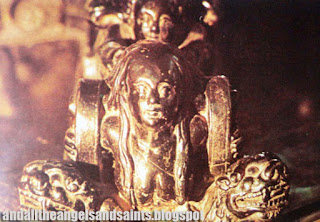Santo Tomas de
Villanueva, bas-relief 18” x 24”.
Miguel Lopez de Legazpi officially established the
colonial city of manila on June 24, 1571. He organized the local government and
laid down the plans of what later would be known as Intramuros, the Walled
City.
He was following the orders of the Real Audiencia in
Spain during the reign of Philip II. “Highest among the design of His Majesty
is the spreading of the Catholic faith”. Going into details, the royal
ordinance instructed: “Alongsie the fortress, you should have a church built
where Mss shall be held and nearby should be a house for the religious..”
Cherubs serving as
column support for the lectern, carving 8” x 19”
Fires burned down the church and the two others that took
its place. In 1599, the cornerstone of the actual church hich stands today was
laid by the Mexican bishop, Pedro Gurto. The original plan was laid by Juan
Macias, but he died before the church and the monastery were finally finished
in 1607. Antonio Herera, an Augustinian lay brother who was supposedly a
relative of the architect lf Escorial, took over and finished the work.
The present church is fully 371 years old an d has
withstood earthquakes and invasions during the colonial era, profanation and
bombings during World War II. In the final dys of the battle for the
liberationof Manila in 1946, the church and the monastery became a refugee camp
for nearly seven thousand people. When the entire Intramuros was razed by
nearly 300 bombs that were dropped each day by American fighter planes, only
San Agustin remained intact—a true miracle. A visible prayer, it stood alone
amid a devastated city that once held as many as twenty equally old and
beautiful churches.
Cherubs and
dragons serving as column support for the base of the lectern, carving 12” x 9”
The façade of San Agustin Church is classic. Four twin
columns support the gable with its rose window. A cross tops the central
pediment. The beautifully carved main door depicts St. Augustine, patron of the
church and of the order. Four granite lions, carved in the Chinese manner,
guard the bases of the columns. They match the two granite lions at the
entrance to the patio.
An odd note about the facade: one tower is notbly missing.
It was taken down after it cracked during the earthquake of 1880. Which is a
pity. From the tower hanged a most historic bell which rang only to announce
good news—and very bad news, such as big fires which often engulfed the Walled
City.
Purgatory, bas relief, 2 x
5”
The central nave is long and high, punctuated with
circular windows through which the light streams in. Two side aisles led to ten
chapels which were donated by the leading clans and families of Manila. One of
these chapels is dedicated to Miguel Lopez de Legazpi,who died in 1572, only a
year after he founded the city. He was buried in the church he provided first
for and his remains have been kept in San Agustin ever since.
Beside the church is the monastery whose lower cloisters
are now a museum housing a collection of colonial Philippine art. Among the
pintings are huge oils that commemorate the life of St. Augustine, his mother
St. Monico and other scholars and holy men who belonged to the Augustinian
order.
Close up view of
the pulpit’s panel.
The large refectory, with seventeenth-century frescoes on
the ceiling, contains religious statuary and paintings as well as mission
furniture from three centuries of the Spanish colonial era. The library contains books and documents of the once
extensive San Agustin archives. Among those on display is a handpainted 17th
century Missal, opened to the page of the Christmas Mass. From the windows of
the library may be seen the botanical garden of father Manuel Blanco whose book
(published in the 19th century) on tropical plants and flowers is a
much cherished volume.
The finest examples of woodcarvings may be found in San
Agustin; within the church and throughout the cloisters. Stunning is the
choir—fro the carvings on its woodwork and on its furniture. The choir seats,
done in the Renaissance style, are often enthusiastically called “jewels of
art”. They are in hardwood with bone inlay. Consisting of 68 seats supported by
colossal arches, it dates back to the 17th century, the work of
artisans from Canton.
Full-length view
of the pulpit with canopy, bas relief
San Agustin is a witness to Philippine colonial history.
The very first school in the country ws opened in its premises; it housed the
first printing press; later it opened the first sanitarium. During the
calamities, it was always a refuge. But
it was not spared from damage, sacking and looting. During the British
Occupation of Manila in 1762, sacred vessels, religious art treasures and the
library of more than 3,000 volumes with manuscripts and incunabula were stolen.
In San Agustin was held the first national synod in 1581
which is of utmost significance for it compelled the colonial government to
abolish slavery. In San Agustin, too, was signed the capitulation of Manila
from the Spaniards to the Americans in 1898. There is a particular irony
here—from it was in San Agustin in 1581 that the legal bsis for the colony was
calrified. It may truly be said that the most outstanding carving on San
Agustin is the inscription of history itself on its very walls.










No comments:
Post a Comment